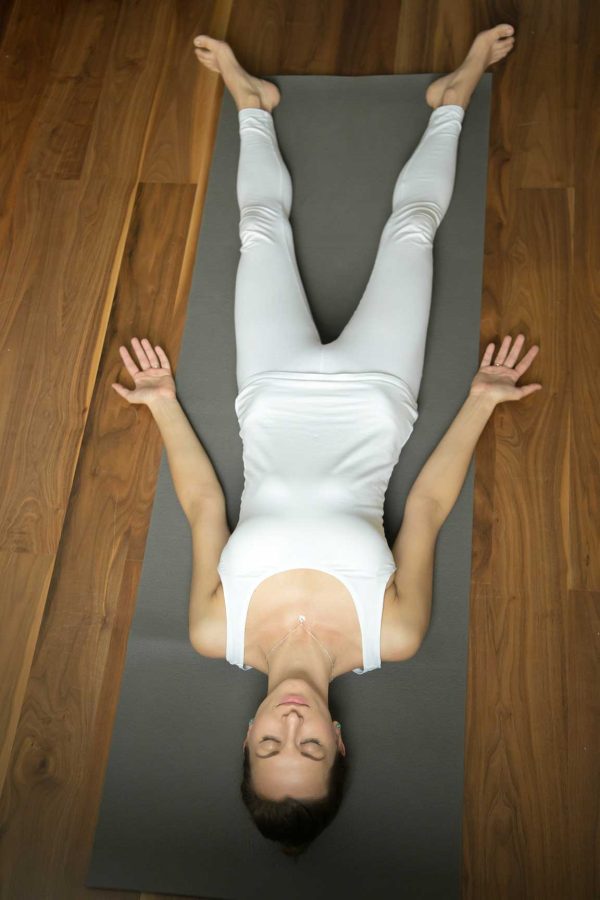“Everything is energy and that’s all there is to it. Match the frequency of the reality you want and you cannot help but get that reality. It can be no other way. This is not philosophy. This is physics.”
Albert Einstein

Yoga Nidra, an ancient practice that balances the mind, body and spirit, helps to maintain physical health while centering the ever-wandering mind. Here at Limitless Potentials, clients can utilize yoga nidra as a part of their brain body mental health treatment plan. This provides the opportunity to experience the many mental health benefits that yoga nidra has to offer.
Here at Limitless, yoga nidra and coaching practices are integrated with a variety of treatment options. All with the aim of enabling the relief of anxiety, lifting depression, stress and anger management, contributing to sensing and obtaining overall wellness. Dr. Kathy is sensitive to the physical and emotional needs of her clients, adjusting the flow and intensity of each clinical session and workshop to create a unique and personal experience on the healing journey.
Qualitative research during Yoga Nidra focuses on understanding the subjective experiences and perceptions of individuals while practicing this deep relaxation technique. Qualitative methods like focus groups and interviews can explore how individuals engage with the practice, their responses to it, and the potential for Yoga Nidra as a clinical intervention.
Exploring the Impact of Yoga Nidra on Sleep:
Researchers might use focus groups to understand participants’ experiences with Yoga Nidra for insomnia, exploring how they perceive the practice and if it helps them relax, fall asleep, or improve their sleep quality.
Investigating Psychological Effects:
Qualitative methods can be used to examine the effects of Yoga Nidra on emotional balance, stress management, anxiety release, and enhanced sense of well-being. Participants might share their experiences of using Yoga Nidra to manage psychological challenges, such as stress, anxiety, negative beliefs, and how it impacted their mental state.
Understanding Individual Experiences:
Qualitative studies can delve into the unique experiences of individuals with Yoga Nidra, exploring the science behind how it impacts their physical and mental state, their informed consent for the practice, and any potential benefits they may experience.
Examining the Use of Yoga Nidra as a Therapy:
Qualitative research can explore the perspectives of individuals using Yoga Nidra for specific conditions, such as depression, anxiety, relapse prevention, and how it might be integrated into their treatment plans.
Assessing Engagement and Retention:
Qualitative methods can be used to understand why individuals engage with Yoga Nidra and what factors might influence their continued practice.
Key Themes Identified in Qualitative Yoga Nidra Research:
Responses to the Practice:
Participants may describe relaxation, perceived sleep, and a sense of withdrawal, highlighting the calming and restorative nature of Yoga Nidra.
Engagement (willingness to try) Factors:
Researchers may identify factors that affect consent to try, such as delivery methods (e.g., in-person vs. online, the environment/location), props available, attunement of the practitioner, and individual preferences.
Potential as a Clinical Intervention:
Qualitative research can explore the potential for Yoga Nidra as a clinical intervention for various conditions, including insomnia, anxiety, addiction, and pain, and complex trauma.
Clinical research showcases the benefits of using yoga nidra in mental health programs. Essentially, these studies indicate yoga can help individuals diagnosed not only with mental health issues, but those also diagnosed with cardiovascular and respiratory disease as well. As it is an exercise therapy that works to combine both body and mind, yoga has long been known for promoting well being and reducing the impact of stress.
Furthermore, along with studies implicating the success of integrative yoga with mental health treatments, other studies show how the brain’s chemicals change with the use of yoga nidra. Specifically, how the brain produces more GABA or gamma-aminobutyric levels with the use of yoga therapy. GABA is a brain chemical that is a signal inhibitor. This means that it reduces the number of signals in the brain. It promotes relaxation, reduces fearful thoughts, and helps with both anxiety and depression.

Dr. Kathy encourages all of her clients to experience yoga sessions and the many helpful benefits of this practice. Before experiencing yoga sessions at the Delray Center for Healing, many mental health patients don’t know what to expect. While there are many forms of yoga and are various types of sessions available through our program, you can expect sessions to include:
Breathwork: One of the ways that yoga works to promote relaxation is to encourage breathwork. These breathing exercises help to improve respiration and circulation.
Physical Poses: Along with breathing, participants may be guided into stretching, which works to relax the body.
Mindfulness Meditation: While practicing various breathing exercises, during yoga nidra, participants practice mindfulness. This focusing technique allows participants to concentrate on the present moment, access options, and further take this mindset throughout daily life.
Guided Imagery: Some yoga sessions may include instructor-guided imagery to assist with mindfulness meditation and the practice of relaxation.
Participants enjoy numerous positive benefits including relaxation, enhanced mood, increased lung capacity, and greater flexibility and strength. Each session relaxes and lengthen muscles, calms the mind, reset the central nervous system, gain new perspectives about life.
Other helpful benefits of yoga nidra for behavioral health include:

Sometimes the healing frequencies of sound are used during integrative yoga therapy sessions.
How does a sound bath work?
In the science of vibrational medicine, there is some compelling research the demonstrates “sound baths” can trigger a phenomenon called “sound healing.” Sound healing has been a healing modality favored by many cultures for thousands of years.
Typically, a sound bath will involve lying in a reclining position after taking part in a restorative yoga class or integrated with mindful practices such as yoga nidra.
The practitioner, trained in sound bath musical techniques and yoga therapy will use one or several instruments to create soothing, overlapping vibrations.
Asking the cortical (thinking) mind to step aside, these vibrations theoretically lead the participant into deeper states of contemplation (consciousness) or relaxation, disengaging the body’s fight-or-flight reflex.
At the end of a session, the practitioner will gently guide you back to a feeling of present awareness before concluding the sound bath, acknowledging the energetic shift that has occurred.
Sound bath instruments
Instruments that make deep, resonating vibrations are popular instruments used for sound baths. These include:

Sound baths may help treat mental health conditions, such as depression and anxiety.
One study of adults measured their feelings before and after a sound bath a mindful session that included a sound bath. The researchers found that tension, anxiety, and negative moods decreased significantly after the therapy session.
A study of participants were asked to listen to the music of Tibetan singing bowls before getting surgery and gave the other 30 headphones with no music. The analysis found that heart rate and other vitals taken prior and after surgery indicate anxiety decreased in those who were given the headphones with music.
Reesearch has reported improvements in distressed mood, tension, anger, and confusion in study participants after a sound bath with Tibetan singing bowls.
Physical pain reduction
Participants asked whether they were in pain, and to rank their pain on a scale from 1 to 5 if they did feel pain. Before a sound bath, these study participants tended to rank their pain higher than they did afterward. More research is needed to confirm whether this trend in pain reduction would reach clinical significance.
Physical symptoms such as blood pressure and heart rate also saw improvement. The review concluded, however, that more research is needed to definitively say sound bath has these effects on most people.
Opportunities to learn and practice yoga nidra are offered at Limitless Potentials. This is a yoga studio is located in Jupiter Bay Plaza. This private practice offers an impressive variety of integrative, somatic, expressive yoga therapy styles.
For more information visit: Limitlesspotentials.com